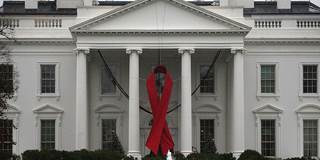The AIDS pandemic claimed some 36 million lives since 1981, and a similar number around the world currently live with the HIV virus. The figures are daunting, but the goal of an “AIDS-free generation” is within reach.
NEW YORK – The AIDS pandemic claimed around 36 million lives between 1981 and 2016, and a similar number around the world currently live with the HIV virus. Some 1.2 million people died of AIDS last year, and another 1.8 million were infected. Those statistics are daunting, but the startling news is that the goal of an “AIDS-Free Generation” is realistically within reach. The required policy steps should be agreed in the early days of US President-elect Donald Trump’s administration.
The key reason that the epidemic can be ended is a scientific finding back in 2011 that showed that HIV-positive individuals receiving antiretroviral (ARV) treatment suppress the HIV virus in their bloodstreams so dramatically that they are very unlikely to transmit the virus to others through sex or shared needles. This finding confirmed the concept of “treatment as prevention.” If a high enough proportion of HIV-positive individuals receive ARV treatment, it is possible not only to save their lives, but also to break the transmission of the virus itself, thereby ending the epidemic.
Building on this idea, AIDS specialists developed two crucial ideas: “90-90-90” and the “cascade of AIDS care.” The 90-90-90 program aims to ensure that by the year 2020, 90% of all HIV-infected individuals know that they are infected (the first 90); 90% of all those who know they are infected are receiving ARV treatment (the second 90); and 90% of all those receiving ARV treatment successfully suppress the HIV virus in the blood. The idea of the cascade is that if each of the three “90s” is achieved, the proportion of all HIV-infected individuals with viral suppression would be 90% x 90% x 90%, which is equal to 72%.

NEW YORK – The AIDS pandemic claimed around 36 million lives between 1981 and 2016, and a similar number around the world currently live with the HIV virus. Some 1.2 million people died of AIDS last year, and another 1.8 million were infected. Those statistics are daunting, but the startling news is that the goal of an “AIDS-Free Generation” is realistically within reach. The required policy steps should be agreed in the early days of US President-elect Donald Trump’s administration.
The key reason that the epidemic can be ended is a scientific finding back in 2011 that showed that HIV-positive individuals receiving antiretroviral (ARV) treatment suppress the HIV virus in their bloodstreams so dramatically that they are very unlikely to transmit the virus to others through sex or shared needles. This finding confirmed the concept of “treatment as prevention.” If a high enough proportion of HIV-positive individuals receive ARV treatment, it is possible not only to save their lives, but also to break the transmission of the virus itself, thereby ending the epidemic.
Building on this idea, AIDS specialists developed two crucial ideas: “90-90-90” and the “cascade of AIDS care.” The 90-90-90 program aims to ensure that by the year 2020, 90% of all HIV-infected individuals know that they are infected (the first 90); 90% of all those who know they are infected are receiving ARV treatment (the second 90); and 90% of all those receiving ARV treatment successfully suppress the HIV virus in the blood. The idea of the cascade is that if each of the three “90s” is achieved, the proportion of all HIV-infected individuals with viral suppression would be 90% x 90% x 90%, which is equal to 72%.